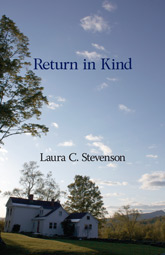A New Series: One Minute Reviews of
Books by Vermont Authors
Laura's column "One Minute Reviews" has appeared bi-weekly in Wilmington, Vermont's Deerfield Valley News since 2015. In April 2018, she found that no Vermont periodical consistently reviews all commercially published fiction and non-fiction by Vermont authors, so she started a series to fill that void. Published reviews from that series and some earlier reviews of local authors are listed with links to a scan of the printed copy. Reviews still in queue are listed without links until they appear in print.
The books reviewed in this series are available through Wilmington's Pettee Memorial Library, the Whitingham Free Public Library, and locally owned Bartleby's Books in Wilmington.
A Hare and a Conversion
Chloe Dalton, Raising Hare: A Memoir. Pantheon Books, 2025
Most people are familiar with the custom of calling a young animal by a name different from its parents’: ‘fawn’ for a young deer; ‘calf’ for a young cow, and so on. But as Chloe Dalton points out in Raising Hare, relatively few people know that a young hare is called a leveret. The term comes from French, in which a hare is a lievre, but the probable reason for its unfamiliarity is that few people think of hares at all, and many casual observers confuse them with rabbits. Dalton makes it clear that she was not one of these; she knew that hares and rabbits are different species, and she also knew that when she was refurbishing an old barn for a country retreat, her workers had dislodged several hares. By her own admission, however, she had thought of hares only as part of the landscape, until a blustery February day when she found a day-old leveret lying in the grass between the two tire marks of the track that led to her house. Realizing it was too young to survive on its own, she waited four hours, but as its mother did not return, she brought it home.
When she called a conservationist to ask for advice about care and feeding, he informed her that that hares, far from becoming domesticated pets like rabbits—or even foxes and badgers—die in captivity. Distressed, she vowed never to keep it captive; she gave it the run of her house, and as it grew older, the run of her walled garden, and finally of the fields surrounding her. Determined to let it return to the wild, she forbore even to name it, referring to it only as “the hare.” Ironically, the hare’s freedom was possible only because Dalton’s liberty was itself so restricted: the Pandemic had forced her to leave London and her exciting, high pressure life as a speech writer for a distinguished MP, an adviser for a major philanthropist, and an aide who traveled to far countries on short notice. Now, confined to what literally became a rural retreat, she worked from a home surrounded by fields and woodland beautifully mapped in the endpapers Denise Nestor designed for the book. And the hare lived there, too.
The result was a coexistence based on deep bond of trust. The hare slept on the step outside Dalton’s study, or crawled between the wheels of her rolling office chair. It tapped her legs when it wanted attention, and when it became old enough to venture over the garden wall and join other hares in the evenings and night, it returned to the house for its daytime slumbers. It had a life of its own, in which its essential nature changed very little: it led a “calm and orderly” existence determined by an internal clock, ran for the sheer joy of running, was constantly on the alert for danger, and asked only a safe place to sleep in the sun. Dalton, however, writes eloquently of the changes the hare has worked in her. Once addicted to a high-pressure life with a “primary colored” view of nature, she became attuned to the hare’s natural world; she thus became concerned with the effect of agri-business on the English landscape, with huge machines largely responsible for the 80% fall in the hare population over the past century. Once interested in the weather only insofar as it made it possible to eat outside in summer, she became aware of the seasons; once shrugging at the mechanized destruction of hedges, she became aware of hedges’ importance to small animals, birds, and hares. As she wryly says, it is unremarkable for awareness of nature to change the assumptions of a human being—but her lovely book, with Denise Nestor’s beautiful drawings of hares and leverets, is a wonderful testimony to the changes in her outlook, and an unspoken invitation to her readers to join her.


